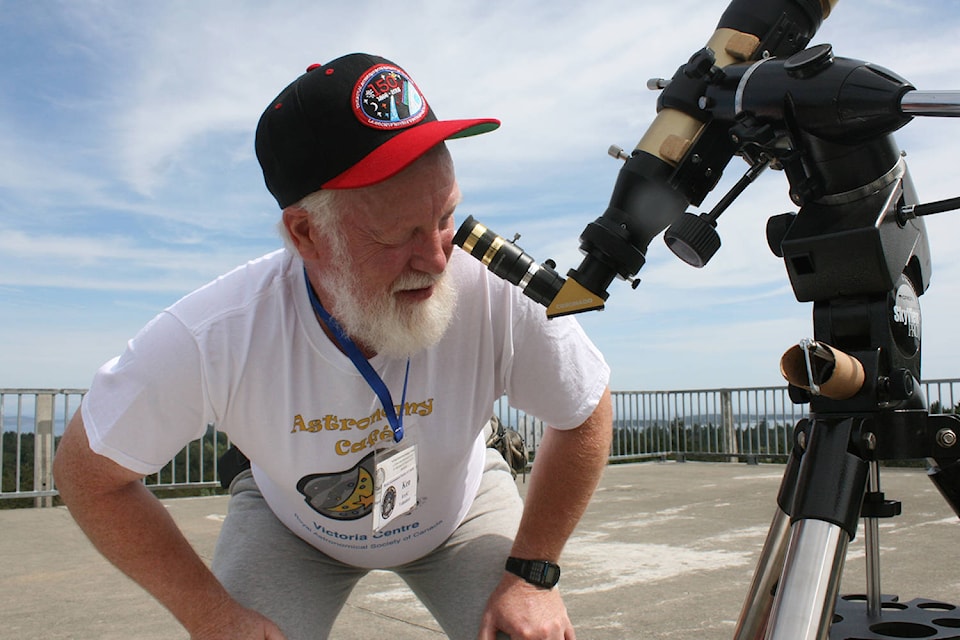Twilight will descend upon Saanich Monday morning as the moon rotates between the sun and the Earth during the coming solar eclipse.
“With the sun being covered by 90 per cent, you will just see a small sliver…of the sun,” said Ken Mallory, spokesperson for the Victoria Centre of the Royal Astronomical Society of Canada (RASC). “It will be quite significant. You will probably notice that the birds stopped singing and the insects stopped flying around, thinking it is twilight.”
Monday’s solar eclipse technically qualifies as a partial one. But Saanich – like the entire Greater Victoria region – will be at the very edge of the eclipse’s path of totality, where the moon blocks out 100 per cent of the sun. In fact, southern Vancouver Island is the best place in Canada to watch the solar eclipse, which scientists have called the Great American Eclipse, because it will be the first total solar eclipse to streak across the entire continental United States in 99 years.
But it is also of considerable interest to Canadian observers. The last major eclipse in the region dates back to 1979 and the next major one will not occur until the 2040s. This timetable has made Monday’s eclipse one of the most anticipated dates in the local astronomy community, with the Royal Astronomical Society of Canada hosting three events in the region.
Mallory will set up two telescopes on the top of Mount Tolmie. RASC members will also set up telescopes in front of the Bell Tower at the Royal B.C. Museum at 675 Belleville St. in Victoria and at the Cricket Pitch in Metchosin behind the Fire Hall at 4400 Happy Valley Rd.
The University of Victoria is also hosting a solar eclipse open house at its observatory that will allow the public to safely and clearly view the eclipse. People are welcome to drop in throughout the morning, but capacity is limited to 100 people at a time. The event is free and no pre-registration is necessary, the university said in a release.
The eclipse will start about 9:10 a.m. and end about 11:45 a.m. It will reach its climax between 10:15 and 10:20 when it will look as if the moon is covering anywhere between 90 and 92 per cent of the sun. For more see, here.
Once upon a time, societies in various stages of scientific development viewed solar eclipses as ominous harbingers of future calamities or divine punishments for past misdeeds. Such days ended some time ago. Advances in mathematics, physics and scientific instrumentation now allow astronomers to predict and probe solar eclipses with immense precision. And yet, the coming celestial ballet between humanity’s one and only home, its solitary satellite and its life-giving star promises to generate considerable interest.
“People still find it very significant to actually be able to view the moon travel in front of the sun,” said Mallory. What makes a total solar eclipse so unique is the fact that the sun is about 400 times larger than the moon, but also about 400 times farther away from the Earth, thereby ‘cancelling’ each other out, he said.
“It is just amazing, and it happens nowhere else that we can view it in the solar system, except on Jupiter,” he said. Humans however cannot stand on the surface of Jupiter. “So we are quite fortunate here in the solar system.”
In fact, some people, so-called eclipse chasers, travel around the world to experience what Saanich residents will come very close to experiencing: a total eclipse of the sun.
This phenomenon of eclipse-chasing – many call it an addiction – dates back to the advent of affordable, accessible travel and cultural analysts have interpreted it as a search for magic in an age of cold, calculating algorithms.
“As a psychologist, I believe the total eclipse is a peak human experience, and more than a moment of pure bliss,” writes Kate Russo, an Australian psychologist in Being in the Shadow: Stories of the First-Time Total Eclipse Experience. “It is difficult to put the experience into words, and difficult to convey to others. The total eclipse is not just what we see, but it is also what we feel, how it changes us, and what we then become.”
If the eclipse promises transcendence and transformation, it also bears risks.
“Don’t look at the sun directly,” said Mallory. “You will need a pair of solar glasses that have the proper solar film, a solar telescope or you can look on the ground and see the sun between the shapes of the leaves. You can get a small mirror and put it on a window sill and project the sun’s image onto a wall in a darkened room. You can poke a pinhole in a piece of paper and hold it over the ground and see the image of the sun on the ground.” Shade 14 welding glasses also offer protection, he said. For additional safety information, Mallory recommends NASA’s eclipse site.
“We had one member who was a little girl, who thought she should use double-dark sunglasses and put a burn mark in her eye that took years to disappear,” said Mallory, adding that his group will hand out solar glasses for the first 70 people who show up. So a little caution can make a big difference in what promises to be a memorable event.
This of course raises a final question: what would be an appropriate piece of music?
“If I had to guess, the [opening] from 2001: A Space Odyssey,” said Mallory.



